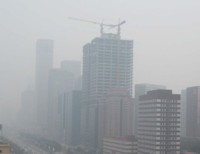Air pollution exceeds safety limits in big Asian cities
 Air pollution in major cities in Asia
Air pollution in major cities in Asiaexceeds the World Health Organisation’s (WHO) air quality
guidelines and toxic cocktails result in more than 530,000
premature deaths a year, according to a new report issued on
Tuesday
Outdoor
Air Pollution and Health in the Developing Countries of Asia: A
Comprehensive Review, is the first comprehensive
literature review to come out of the U.S.-based
Health Effects Institute, Public Health and Air
Pollution in Asia (PAPA) program.
The study
notes that Asia is undergoing economic development at
a rapid rate, resulting in levels of urban air pollution in many
cities that rival the levels that existed in Europe and North
America in the first decades of the 20th century. This development
is also transforming the demographic and epidemiologic
characteristics of the population in ways that are likely to affect
its vulnerability to air pollution.
Nearly two thirds of the estimated 800,000 deaths and
4.6 million lost years of healthy life worldwide caused by exposure
to urban air pollution in 2000 occurred in the developing countries
of Asia (also referred to as “developing Asia”; World Health
Organization [WHO*] 2002).
In rural areas and urban slums, indoor air
pollution from the burning of solid fuels confers its own large
burden of disease and contributes to increased outdoor
concentrations of pollutants in some locales.
Developing
Asia’s poorest populations are also susceptible to the unexpected
effects of climate change, including possibly substantial health
effects.
The review
builds on an initial assessment conducted in 2004 and describes the
current scope of the Asian literature on the health effects of
outdoor air pollution, enumerating and classifying more than 400
studies.
In addition, the report includes a systematic
and quantitative assessment of 82 time-series studies of daily
mortality and hospital admissions for cardiovascular and
respiratory disease.
The studies
covered in the current review include the PAPA time-series studies
in four Asian cities as well as a first-ever critical and
qualitative analysis of Asian studies of long-term exposure to air
pollution and chronic respiratory disease, lung cancer, and adverse
reproductive outcomes that describes both what the studies tell us
and the continuing uncertainties and research needs.
Based on
findings from more than 80 Asian time-series studies, including
coordinated multi-city time-series studies, the same pollutants -
RSP and gaseous pollutants such as ozone (O3), SO2, and NO2 -
affect older people with chronic cardiovascular or respiratory
disease.
The adverse
effects in some locales may reflect the effects of air pollution
concentrations that have subsequently decreased. However, more
recent studies continue to report adverse effects at lower levels
in cities in Thailand and Japan, where air quality has improved, as
well as in heavily polluted Chinese and Indian cities.
The report
also provides a broad overview of the status of and trends in air
pollution sources, emissions, and exposures in the developing
countries of Asia, as well as factors related to urban development,
population health, and public policy that set the context for the
public health effects of air pollution.
The review
concludes by placing the Asian health effects studies in the
context of the worldwide literature, identifies gaps in knowledge,
and recommends approaches by which to address them.
target=”_blank”>The Executive Summary is available
here
Source: www.healtheffects.org

